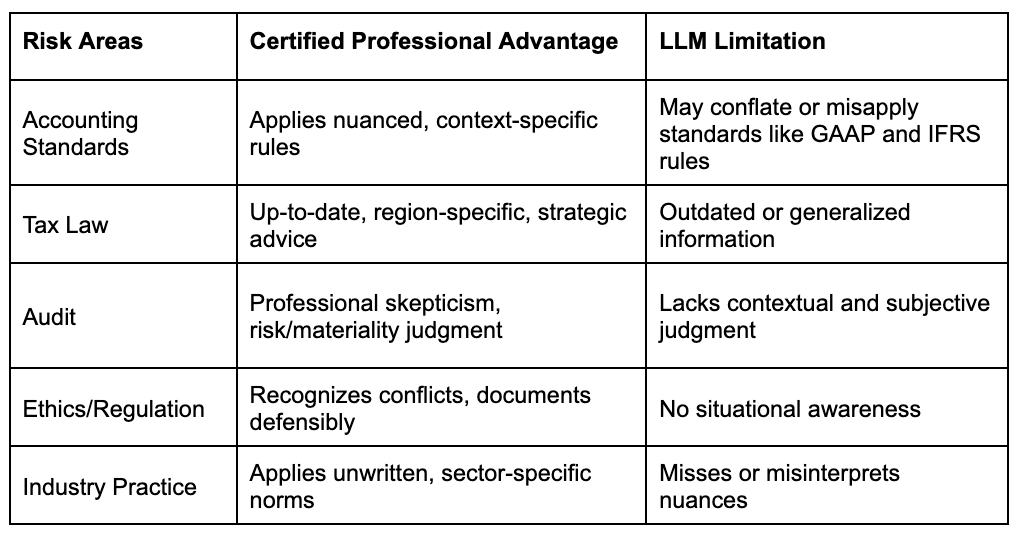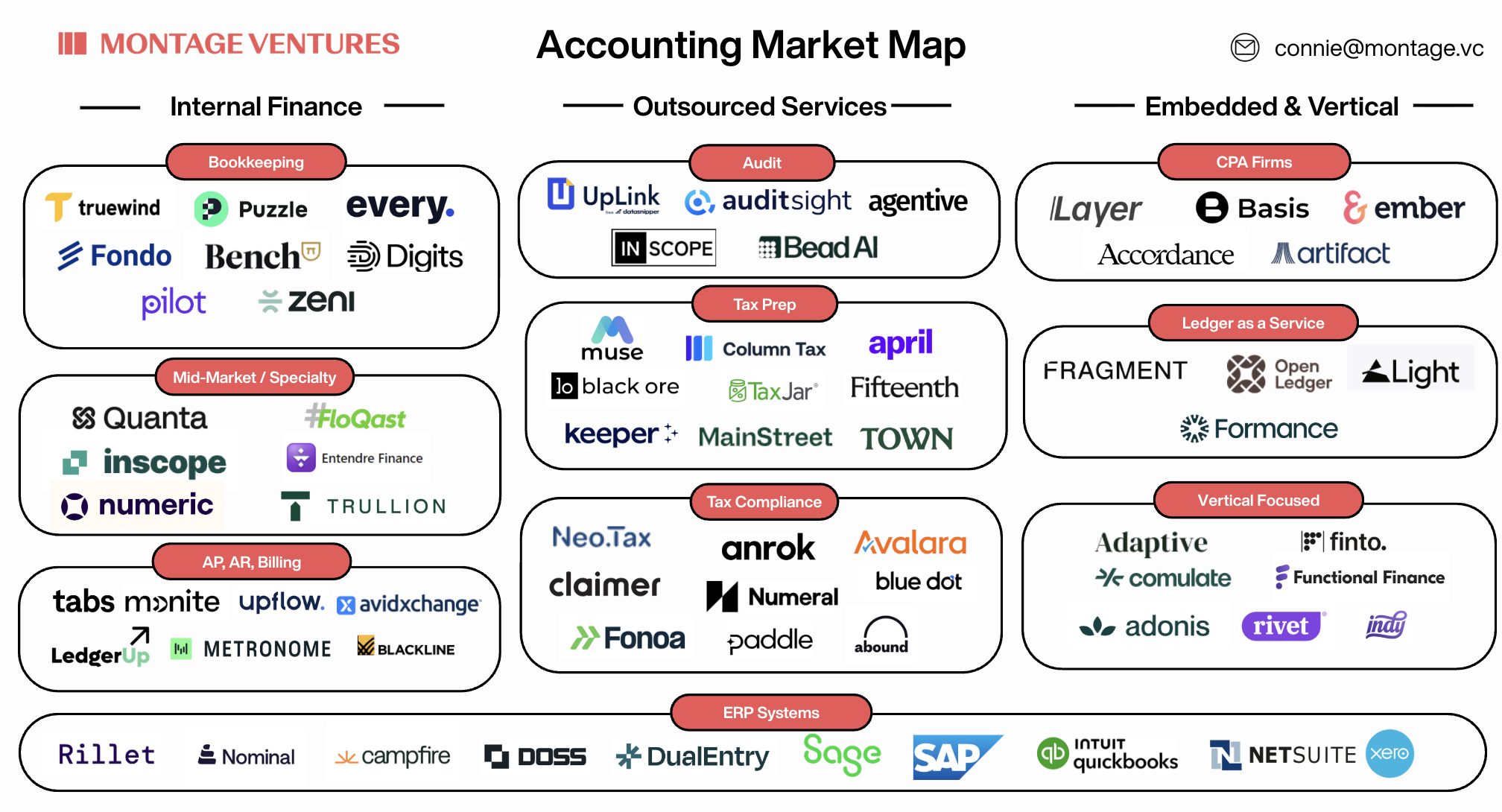The Promise of AI in Accounting and Tax


$145B
Market size of accounting services in the US
~46,000
Estimated CPA Firms in the US
671k
Actively licensed CPAs in the US
Navigating a Talent Crisis and a Technological Transformation
The accounting industry is undergoing rapid change, driven by an exodus of workers, resulting in a shortage of talent. The WSJ reported that from 2021 to 2023, 17% of the CPA workforce in the United States left the field – representing over 300,000 qualified accountants who resigned, switched careers or retired. Recent trend reports highlight a 37% decrease in CPA exam candidates since 2016. As a consequence, organizations are hiring less qualified or even non-accounting graduates, investing heavily in training, and facing high attrition rates (22% among first-year professionals). This cycle is costly and unsustainable, pushing CPA firms to seek software solutions to maintain efficiency and compliance.
The Perfect Automation Story
Accounting workflows are inherently structured but often highly manual. They involve a series of steps, including: data entry, categorization, approvals, reconciliations, and reporting, each requiring a high level of accuracy and compliance. While the general workflow is similar across businesses, the complexity and specialization increase with company size, industry, and regulatory requirements.These workflows are also nuanced, demanding technical knowledge and domain expertise, such as on tax laws and audit standards.
Manual processes today are prone to errors, bottlenecks, and inefficiencies. Human mistakes in financial data cost U.S. businesses over $3.1 trillion annually, riddled by manual data entry, spreadsheet workflows, and approval delays.
AI can streamline accounting by automating previously unscalable tasks:
- Data Entry and Extraction: LLMs can process invoices, receipts, and contracts, extracting relevant financial data and reducing the need for manual input.
- Categorization and Reconciliation: AI can automatically categorize transactions and match them with bank statements, streamlining reconciliation and reducing errors
- Document Understanding: LLMs can read, interpret, and summarize complex financial documents, making it easier to prepare reports and audits.
- Workflow Automation: AI-driven platforms can automate approvals, flag anomalies, and ensure compliance, freeing accountants to focus on higher-value tasks.
Technical Challenges and Approaches to Accuracy
While LLMs can assist with preliminary reviews, drafting summaries, and highlighting anomalies, they are not yet a replacement for expert human judgment in complex financial analysis. Despite the promise of AI, several challenges remain:
- Quality Data and Training: High quality data is needed to improve LLM accuracy within accounting and finance. If the underlying financials are incomplete or formatted inconsistently, the analysis can be flawed. Within the accounting and finance space specifically, there is an appetite for greater data availability on types of documents and datasets that do not exist within the public domain. For example, there are no publicly accessible databases of individual 1040 tax forms or Form 1120 (U.S. Corporation Income Tax Return) documents that might accurately reflect true SMB books and financials. Real world data can be messy, with noisy transactions, posing both a challenge and a potential data moat for companies building in the space.
- Numerical Reasoning: LLMs are not inherently designed for advanced quantitative analysis or financial modeling. They may misinterpret numbers, overlook context, or make basic calculation errors. Recent techniques to mitigate inaccuracies include precision-optimized architectures and symbolic augmented reasoning, adding structural interventions to ensure a high level of trust and accuracy.
- Infinite, Contextual Understanding: Infinite context windows are highly relevant for AI companies focused on financial analysis, where the ability to process and reason over long-term, complex data streams is crucial. Financial analysis often involves reviewing lengthy documents, historical records, and large datasets. Infinite context windows allow AI models to consider the full scope of this information without losing earlier context, leading to more accurate insights and recommendations. In addition, many tasks require understanding trends, patterns, and relationships that span years or decades – allowing AI to maintain context and coherence.
💡 Recent innovations, such as segmenting input and using sliding windows or compressive memory, aim to reduce these costs by only retaining and processing the most relevant parts of the input at each step. However, increased computational cost should be judged against business value. In many financial applications, the benefits of deeper, more accurate analysis can justify the higher costs, especially for high-stakes use cases.
- Domain Expertise: Financial statements are nuanced, with industry-specific metrics and regulatory requirements requiring AI systems to be finely tuned and up to date. LLMs may lack the domain expertise to spot subtle red flags or interpret complex disclosures. For example, accountants develop expertise in industry-specific practices (e.g., construction percentage-of-completion, banking loan loss reserves) that are not always codified and may be missed by general LLMs.
The Road to Greater Accuracy and Potential Risk Areas
Today, general-purpose LLMs struggle to exceed 70% accuracy in real-world accounting tasks. Human professionals still consistently outperform LLMs, particularly on subjective or ambiguous cases such as the examples below:

Nuanced Application of Accounting Standards
- Distinguishing Between GAAP and IFRS: LLMs may conflate GAAP and IFRS rules without explicit instruction, while a CPA knows which standard applies in a given context and recognizes subtle differences in revenue recognition, lease accounting, or impairment rules.
- Interpretation of Ambiguous Transactions: Experienced accountants exercise judgment in classifying edge-case transactions (e.g., complex derivatives, hybrid instruments) where rules are not clear-cut. LLMs tend to generalize and may misclassify such transactions.
Tax Law Complexity and Updates
- Application of Recent Tax Law Changes: LLMs can provide outdated information if their training data does not include the most current tax laws, regulations, or IRS guidance. Professionals stay current through continuing education and professional updates, ensuring compliance with the latest rules.
- State and Local Tax Nuances: Certified tax professionals understand intricate state and local tax rules, apportionment formulas, and specific exemptions, which LLMs often overlook or misapply due to a lack of granular regional data.
- Tax Planning Strategies: CPAs and tax attorneys use advanced planning strategies (e.g., like-kind exchanges, multi-entity structuring, international tax treaties) that require both technical knowledge and practical experience, which LLMs cannot reliably replicate.
Audit Judgment and Risk Assessment
- Professional Skepticism: Auditors apply skepticism and recognize red flags in client behavior or documentation that may not be evident from data alone. LLMs can struggle to weigh context, intent, or subtle inconsistencies in evidence.
- Materiality and Risk Assessment: Determining materiality thresholds and audit risk involves both quantitative and qualitative judgment, often tailored to the industry, client, and specific engagement.
- Recognizing Conflicts of Interest: Professionals are trained to identify and manage conflicts of interest, independence issues, and ethical dilemmas—areas where LLMs have no situational awareness or regulatory context.
Opportunities to Build AI Applications for Accounting
The intersection of AI and accounting offers fertile ground for innovation:
- Automated Bookkeeping: AI-powered platforms can handle day-to-day transaction processing, reducing the need for manual entry.
- Smart Audit Tools: AI can flag unusual transactions, automate compliance checks, and streamline audit workflows.
- AI CFO: Machine learning can forecast cash flow, identify financial risks, and support strategic planning.
- Personalized Advisory Services: AI can analyze client data and provide tailored financial advice, enhancing the value accountants deliver.

Picking a lane: Within the market landscape, there are core distinctions in founder approaches choosing between 1) vertical solutions in nuanced industries (i.e. healthcare, construction) or horizontal solutions (i.e. ERP systems or bookkeeping automation). In addition to verticals, distribution strategy matters in serving SMB, mid-market, or large enterprise clients – each with its own unique tradeoffs. On the other side of the services industry, we see embedded approaches selling directly to platforms or accounting firms versus end clients.
Distribution strategy: At Montage, we’re most excited about the sweet spot of the mid-market segment that constitutes readiness of adoption, larger budgets, and opportunity to automate significant manual workflows that come with scale. In addition to serving end clients, we believe that an embedded approach, in closely partnering with experts at accounting firms or platforms for unique data access will lead to more accurate workstreams and models.
Wedge: We believe platforms that start with the atomic unit of real-time ledgering will have the greatest technological moat and flexibility to expand into other core functions over time, such as reconciliation, bookkeeping, and any financial analysis. Building a robust, dynamic ledgering infrastructure that removes the need for stitching together legacy ERP systems and siloed financial platforms, coupled with seamless workflows, will create stickiness.
Segment, Automation Focus, & Key Applications
1. SMBs: Cost-effective core automation
- Opportunities: Real-time revenue tracking, receipt digitization, unified P&L dashboards. The majority of accounting firms in the US (>90%) are small practices with solo practitioners or few employees
- Characteristics: Clients might utilize more basic accounting software or even manual processes like spreadsheets
- Challenges: Potentially lower adoption rates due to cost concerns and a need for efficient user acquisition at scale
2. Mid-Market: Efficiency & compliance scaling
- Opportunities: More complex VAT processing, budget optimization, anomaly alerts, AP automation
- Characteristics: Simpler accounting standards like GAAP or even cash-basis accounting compared to enterprise
- Challenges: May have challenges establishing robust internal controls due to limited staff, potentially requiring one individual to handle multiple processes
3. Enterprise: Complex data management
- Opportunities: Real time reporting, analytics, and approval workflows across financial entities, geographies, and internal data systems
- Characteristics: High volume of transactions and complex financial structures, including multiple departments, entities, and locations. This necessitates robust, centralized accounting systems, processes, and integrations into ERP systems
- Challenges: Subject to more stringent regulatory requirements for financial reporting (e.g., SEC regulations), requiring detailed financial statements and audits
Looking Ahead
The accounting industry’s talent shortage and manual workflow challenges are driving rapid adoption of AI and automation. While LLMs and other AI tools offer significant benefits of reducing errors, automating repetitive tasks, and enabling more strategic work, they are still not fully accurate for complex financial analysis. The future of accounting lies in the collaboration between skilled professionals and intelligent automation, creating opportunities for innovation and a renewed spark in the profession.
If you're a founder building in any of these related areas, we'd love to explore how to partner with you. Please reach out to connie@montageventures.com














